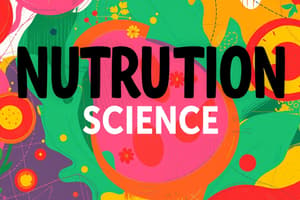Podcast
Questions and Answers
What is a key difference between a registered dietitian and a nutritionist?
What is a key difference between a registered dietitian and a nutritionist?
- Nutritionists must have clinical experience in nutrition.
- Registered dietitians have no formal credential.
- Registered dietitians must have a college degree in dietetics. (correct)
- Nutritionists must pass a registration examination.
Which of the following is considered 'public domain' information?
Which of the following is considered 'public domain' information?
- MyPlate food guidance system (correct)
- Individual nutrition plans
- A proprietary weight loss program
- Medical treatments
What is the energy value of lipids per gram?
What is the energy value of lipids per gram?
- 7 kcal/g
- 9 kcal/g (correct)
- 6 kcal/g
- 4 kcal/g
How many total kcal are in a meal containing 20 g of protein and 100 g of carbohydrates?
How many total kcal are in a meal containing 20 g of protein and 100 g of carbohydrates?
Which Dietary Reference Intake (DRI) should be used when making dietary recommendations?
Which Dietary Reference Intake (DRI) should be used when making dietary recommendations?
What is the recommended vitamin D intake for a 25-year-old male?
What is the recommended vitamin D intake for a 25-year-old male?
What is the function of the Tolerable Upper Intake Level (UL)?
What is the function of the Tolerable Upper Intake Level (UL)?
What distinguishes a nutrient content claim from a health claim?
What distinguishes a nutrient content claim from a health claim?
What is digestion primarily defined as?
What is digestion primarily defined as?
What is the primary role of the mouth in the digestive process?
What is the primary role of the mouth in the digestive process?
Which organ is responsible for the majority of chemical digestion and nutrient absorption?
Which organ is responsible for the majority of chemical digestion and nutrient absorption?
What is the main function of the pancreas in digestion?
What is the main function of the pancreas in digestion?
What occurs during the absorption phase of digestion?
What occurs during the absorption phase of digestion?
What role does the gallbladder play in digestion?
What role does the gallbladder play in digestion?
Which of the following describes a part of mechanical digestion?
Which of the following describes a part of mechanical digestion?
What is the purpose of the elimination phase in digestion?
What is the purpose of the elimination phase in digestion?
What is the primary function of emulsification in digestion?
What is the primary function of emulsification in digestion?
Which component of saliva is responsible for neutralizing acid?
Which component of saliva is responsible for neutralizing acid?
What mechanism allows the absorption of nutrients into the bloodstream in the small intestine?
What mechanism allows the absorption of nutrients into the bloodstream in the small intestine?
How do peristalsis and segmentation differ?
How do peristalsis and segmentation differ?
Which of the following statements about active transport is correct?
Which of the following statements about active transport is correct?
What role does lysozyme play in saliva?
What role does lysozyme play in saliva?
In the context of small intestine absorption, what is endocytosis?
In the context of small intestine absorption, what is endocytosis?
What is the primary purpose of bile synthesized by the liver?
What is the primary purpose of bile synthesized by the liver?
What is the primary function of haustration in the proximal colon?
What is the primary function of haustration in the proximal colon?
What characterizes mass movement in the colon?
What characterizes mass movement in the colon?
Which of the following best defines catabolism?
Which of the following best defines catabolism?
How does the Basal Metabolic Rate (BMR) differ from the Resting Metabolic Rate (RMR)?
How does the Basal Metabolic Rate (BMR) differ from the Resting Metabolic Rate (RMR)?
What is the primary energy source for cellular processes?
What is the primary energy source for cellular processes?
Which energy system is specifically utilized for powerful, short-burst activities?
Which energy system is specifically utilized for powerful, short-burst activities?
What are the conditions required for measuring Basal Metabolic Rate (BMR)?
What are the conditions required for measuring Basal Metabolic Rate (BMR)?
What happens to BMR as a person ages?
What happens to BMR as a person ages?
What does a 'fat-free' nutrient content claim indicate?
What does a 'fat-free' nutrient content claim indicate?
Which of the following claims indicates that a food has at least 25% less of a nutrient when compared to a baseline?
Which of the following claims indicates that a food has at least 25% less of a nutrient when compared to a baseline?
What does a 'lean' nutrient content claim specify regarding fat and cholesterol?
What does a 'lean' nutrient content claim specify regarding fat and cholesterol?
Which health claim is associated with adequate calcium intake?
Which health claim is associated with adequate calcium intake?
Which of the following claims is true about 'low sodium'?
Which of the following claims is true about 'low sodium'?
A food labeled as 'sugar-free' must have what maximum amount of sugar per serving?
A food labeled as 'sugar-free' must have what maximum amount of sugar per serving?
What does the term 'rich' refer to in nutrient content claims?
What does the term 'rich' refer to in nutrient content claims?
Which condition relates to dietary fat reduction for health claims?
Which condition relates to dietary fat reduction for health claims?
Which health claim is associated with soluble fiber?
Which health claim is associated with soluble fiber?
What does a 'low calorie' claim indicate about a food item?
What does a 'low calorie' claim indicate about a food item?
What is the threshold for a 'good source' nutrient claim?
What is the threshold for a 'good source' nutrient claim?
Which nutrient is associated with reducing the risk of neural tube defects?
Which nutrient is associated with reducing the risk of neural tube defects?
What does the term 'light' imply in nutrient claims?
What does the term 'light' imply in nutrient claims?
What health benefit is associated with increased potassium intake?
What health benefit is associated with increased potassium intake?
Study Notes
Registered Dietitian vs. Nutritionist
- Registered Dietitians (RD) require a college degree in dietetics, clinical nutrition experience, and have passed a registration examination.
- Nutritionists may not have formal education or credentials and do not have universally recognized qualifications.
Public Domain Information
- MyPlate food guidance system is publicly available.
- Dietary guidelines and hydration recommendations are considered public domain.
- Precautions for training in high temperatures also fall under this category.
Energy-Provisioning Macronutrients
- Carbohydrates and proteins provide 4 kcal/g.
- Lipids yield 9 kcal/g.
- Alcohol contributes 7 kcal/g.
Meal Caloric Calculation
- A meal with 20g of protein and 100g of carbohydrates results in 480 kcal (20g x 4 + 100g x 4).
Dietary Reference Intakes (DRIs)
- EAR: Estimated Average Requirement for 50% of the population.
- RDA: Recommended Dietary Allowance suffices for nearly all (97-98%) individuals.
- AI: Adequate Intake level used when there is no established EAR.
- UL: Tolerable Upper Intake Level, the maximum daily intake without health risks.
Recommended Vitamin D Intake
- A 25-year-old male should aim for an intake of 600 IU of vitamin D.
Nutrient Content Claims vs. Health Claims
- Nutrient Content Claims are FDA-approved, highlighting specific food characteristics (e.g., "Fat-free" contains <0.5g of fat).
- Health Claims describe potential health benefits from consuming a nutrient (e.g., "Calcium reduces the risk of osteoporosis").
Digestion, Absorption, and Elimination
- Digestion breaks food down into molecules.
- Absorption allows nutrients to enter the bloodstream via the intestinal wall.
- Elimination excretes undigested food and waste.
GI Tract Organs and Function
- Mouth initiates ingestion, mechanical and chemical digestion.
- Stomach further digests food, both mechanically and chemically.
- Small intestine is where most digestion and absorption occur.
- Large intestine absorbs water, vitamins, and forms waste.
Accessory Organs
- Pancreas produces digestive enzymes and hormones, including insulin and glucagon.
- Gallbladder stores bile for lipid emulsification.
- Liver synthesizes bile and processes nutrients for circulation.
Mechanical vs. Chemical Digestion
- Mechanical digestion involves physical breakdown of food (e.g., chewing).
- Chemical digestion utilizes saliva and enzymes to break down molecules.
Small Intestine Features
- Segmentation and peristalsis mix chyme with digestive juices.
- Nutrients absorbed into blood/lymph via enterocytes.
Absorptive Mechanisms
- Passive Diffusion: Molecules move across membranes with concentration gradient.
- Facilitated Diffusion: Molecules require a carrier protein but no energy.
- Active Transport: Molecules move against concentration gradient, needing energy.
- Endocytosis: Cells engulf molecules into their interior.
Peristalsis vs. Segmentation
- Peristalsis: coordinated contractions moving food along the GI tract.
- Segmentation: rhythmic contractions mixing chyme, maximizing enzyme contact.
Haustration and Mass Movement
- Haustration: slow contractions in the colon that help move waste.
- Mass Movement: forceful contractions that push waste toward the rectum.
Catabolism vs. Anabolism
- Catabolism: breakdown of molecules for energy release.
- Anabolism: synthesis of complex structures using energy.
BMR vs. RMR
- BMR: minimum energy to maintain life, measured under strict conditions.
- RMR: slightly higher than BMR, can be measured in less controlled settings.
BMR Changes with Weight and Age
- BMR decreases with weight loss and generally declines with age due to muscle loss.
Source of Energy for Biological Processes
- ATP (Adenosine Triphosphate) is the primary energy currency for cellular functions.
Energy Systems in Physical Activity
- Phosphagen system: immediate energy for short bursts of activity (1-3 minutes).
- Aerobic Energy System: sustained energy production during longer activities.
- Anaerobic Energy System: energy production without oxygen for moderate durations.
Studying That Suits You
Use AI to generate personalized quizzes and flashcards to suit your learning preferences.
Description
Explore the differences between Registered Dietitians and Nutritionists, their educational requirements, and credentials. Understand essential concepts like energy-providing macronutrients, Meal Caloric Calculation, and Dietary Reference Intakes (DRIs) to enhance your nutritional knowledge.




